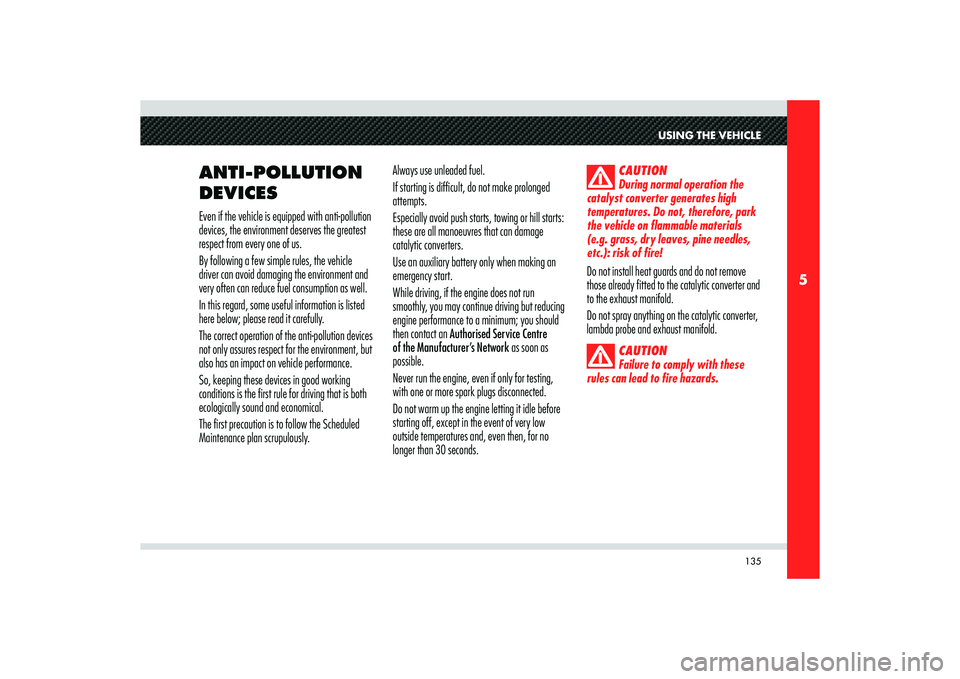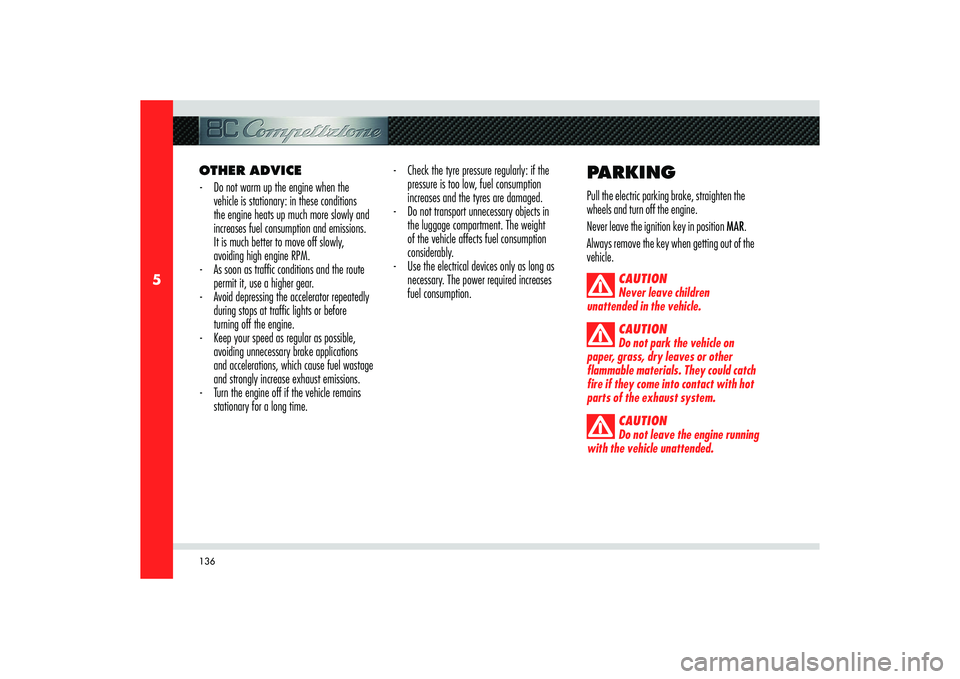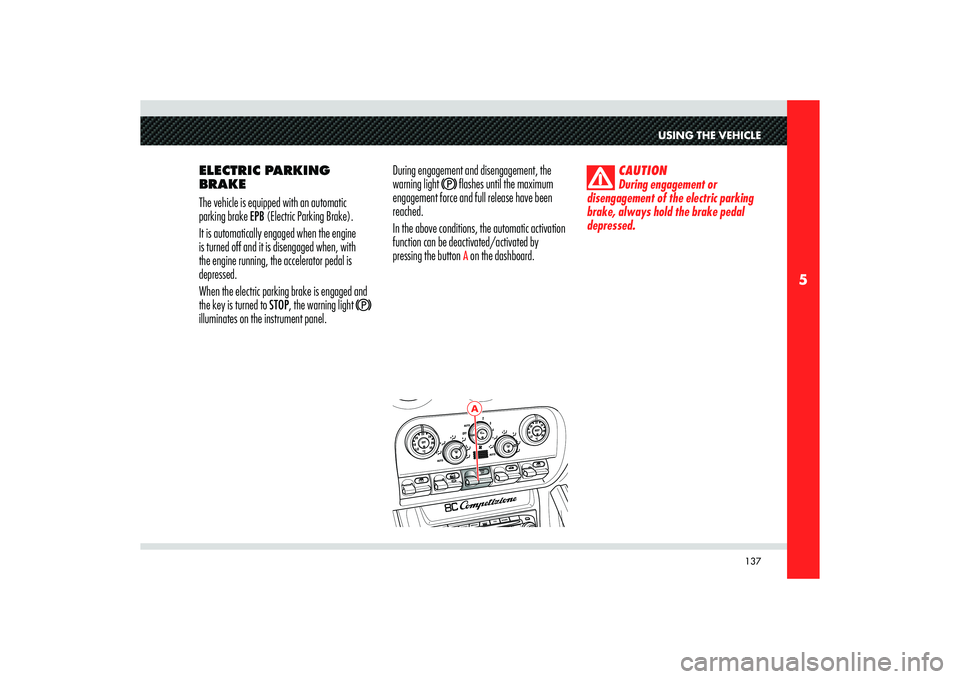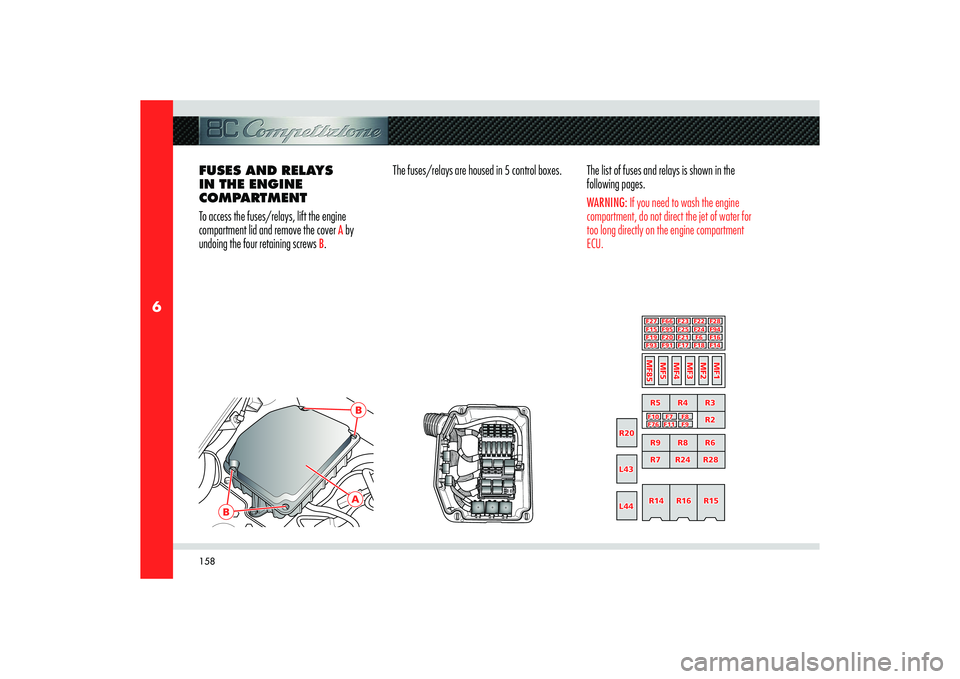engine Alfa Romeo 8C 2010 Owner handbook (in English)
[x] Cancel search | Manufacturer: ALFA ROMEO, Model Year: 2010, Model line: 8C, Model: Alfa Romeo 8C 2010Pages: 223, PDF Size: 14.35 MB
Page 134 of 223

132
5
TRAVELLING
- Caution is the fi rst rule for safe driving.
Being careful also means being in a position
to be able to predict the driving behaviour
of other drivers, that may be wrong or
careless.
- Keep a safe distance from vehicles in front
of you, adjusting this distance in accordance
to the vehicle speed and traffi c conditions.
- Strictly follow the traffi c regulations
applicable in each country and above all,
respect the speed limits.
- Long trips should be started in optimal
physical condition.
CAUTION
Drunk driving, or driving
under the influence of drugs or certain
medicines is extremely dangerous for
the driver and for others.CAUTION
Always fasten the seat belts.
Travelling without your seat belt
fastened increases the risk of serious
injury in the event of a collision.
- Make regular stops to loosen up your limbs
and refresh yourself, and avoid driving for
hours on end.
- Ensure that the air inside the passenger
compartment is changed constantly.
- Never coast downhill with the engine off:
the braking action requires greater effort on
the pedal due to the absence of the engine
brake and the power braking system. DRIVING AT NIGHT
The main guidelines to follow when driving at
night are set out below:
- Drive with the greatest caution: at night the
driving conditions are more demanding.
- Reduce your speed, especially on roads with
no street lights.
- At the fi rst signs of drowsiness, stop: to
continue driving would be a risk for yourself
and for others. Continue only after you have
had a rest.
- Keep the vehicle at a greater distance from
vehicles in front of you than you would
during the day: it is diffi cult to assess the
speed of other vehicles when you can only
see the lights.
- Make sure that the headlights are aimed
correctly: if they are too low, they reduce
visibility and strain the eyes. If they are too
high, they may bother the drivers of other
cars.
Page 136 of 223

134
5
Sound the vehicle horn rhythmically if you hear
another vehicle approaching.
- When you get out of the vehicle, put on the
high-visibility vest.DRIVING IN THE
MOUNTAINS
On downhill roads, use the engine brake,
engaging low gears so as not to overheat the
brakes.
- Never coast downhill with the engine off or
in neutral, and never with the ignition key
removed.
- Drive at a moderate speed and avoid
“cutting” corners.
- Remember that passing other vehicles when
driving uphill is slower and thus requires
more free distance on the road. If you are
being overtaken on a hill, slow down and
allow the other vehicle to pass. DRIVING ON SNOW OR
ICE
Below is some general advice for driving in these
conditions:
- Keep a very moderate speed.
- Fit snow chains or specifi c tyres if the road
is covered with snow: see the chapters
“Snow chains” and “Winter tyres” in this
section.
- Mainly use the engine brake and avoid
sharp braking.
- We recommend that you activate “Low
grip” mode (see page 122).
- Avoid sudden acceleration and sharp
changes in direction.
- During the winter season, even apparently
dry roads can have icy sections. Be careful
when crossing bridges, viaducts and roads
that have little exposure to the sun and are
bordered by trees and rocks. They may be
icy.
- Keep a safety distance from the vehicles in
front.
Page 137 of 223

135
5
USING THE VEHICLE
ANTI-POLLUTION
DEVICES Even if the vehicle is equipped with anti-pollution
devices, the environment deserves the greatest
respect from every one of us.
By following a few simple rules, the vehicle
driver can avoid damaging the environment and
very often can reduce fuel consumption as well.
In this regard, some useful information is listed
here below; please read it carefully.
The correct operation of the anti-pollution devices
not only assures respect for the environment, but
also has an impact on vehicle performance.
So, keeping these devices in good working
conditions is the first rule for driving that is both
ecologically sound and economical.
The first precaution is to follow the Scheduled
Maintenance plan scrupulously. Always use unleaded fuel.
If starting is difficult, do not make prolonged
attempts.
Especially avoid push starts, towing or hill starts:
these are all manoeuvres that can damage
catalytic converters.
Use an auxiliary battery only when making an
emergency start.
While driving, if the engine does not run
smoothly, you may continue driving but reducing
engine performance to a minimum; you should
then contact an Authorised Service Centre
of the Manufacturer’s Network as soon as
possible.
Never run the engine, even if only for testing,
with one or more spark plugs disconnected.
Do not warm up the engine letting it idle before
starting off, except in the event of very low
outside temperatures and, even then, for no
longer than 30 seconds.
CAUTION
During normal operation the
catalyst converter generates high
temperatures. Do not, therefore, park
the vehicle on flammable materials
(e.g. grass, dry leaves, pine needles,
etc.): risk of fire!
Do not install heat guards and do not remove
those already fitted to the catalytic converter and
to the exhaust manifold.
Do not spray anything on the catalytic converter,
lambda probe and exhaust manifold.
CAUTION
Failure to comply with these
rules can lead to fire hazards.
Page 138 of 223

136
5
OTHER ADVICE
- Do not warm up the engine when the
vehicle is stationary: in these conditions
the engine heats up much more slowly and
increases fuel consumption and emissions.
It is much better to move off slowly,
avoiding high engine RPM.
- As soon as traffi c conditions and the route
permit it, use a higher gear.
- Avoid depressing the accelerator repeatedly
during stops at traffi c lights or before
turning off the engine.
- Keep your speed as regular as possible,
avoiding unnecessary brake applications
and accelerations, which cause fuel wastage
and strongly increase exhaust emissions.
- Turn the engine off if the vehicle remains
stationary for a long time. - Check the tyre pressure regularly: if the
pressure is too low, fuel consumption
increases and the tyres are damaged.
- Do not transport unnecessary objects in
the luggage compartment. The weight
of the vehicle affects fuel consumption
considerably.
- Use the electrical devices only as long as
necessary. The power required increases
fuel consumption.
PARKINGPull the electric parking brake, straighten the
wheels and turn off the engine.
Never leave the ignition key in position MAR.
Always remove the key when getting out of the
vehicle.
CAUTION
Never leave children
unattended in the vehicle.
CAUTION
Do not park the vehicle on
paper, grass, dry leaves or other
flammable materials. They could catch
fire if they come into contact with hot
parts of the exhaust system.
CAUTION
Do not leave the engine running
with the vehicle unattended.
Page 139 of 223

137
5
A
USING THE VEHICLE
ELECTRIC PARKING
BRAKE
The vehicle is equipped with an automatic
parking brake EPB (Electric Parking Brake).
It is automatically engaged when the engine
is turned off and it is disengaged when, with
the engine running, the accelerator pedal is
depressed.
When the electric parking brake is engaged and
the key is turned to STOP, the warning light
illuminates on the instrument panel.During engagement and disengagement, the
warning light
flashes until the maximum
engagement force and full release have been
reached.
In the above conditions, the automatic activation
function can be deactivated/activated by
pressing the button A on the dashboard.
CAUTION
During engagement or
disengagement of the electric parking
brake, always hold the brake pedal
depressed.
Page 140 of 223

138
5
B
Engagement
The electric parking brake is automatically
applied when the engine is turned off and the
vehicle is stationary.
It can only be disengaged when the engine is
restarted.
When the key is removed or set to STOP it
cannot be disengaged.
The electric parking brake can also be manually
engaged when the vehicle is moving or the key is
turned to MAR by pulling up the lever
B.
If the engine was turned off with the automatic
engagement device deactivated, you can
reactivated it simply by pulling lever B.
CAUTION
Always check that the vehicle is
actually locked before leaving it.
CAUTION
When the EPB button is
activated while driving, the vehicle
slows down with strong deceleration
(Dynamic Braking). It is therefore
advisable to use this function only
in case of an emergency. The vehicle
stability is in any case ensured by the
VDC system, which is always active.
Disengagement
The parking brake automatically disengages
when the accelerator pedal is depressed.
The electric parking brake can also be manually
disengaged when the vehicle is moving or the
key is in position MAR by manually pulling up
lever
B and simultaneously depressing the brake
pedal.
WARNING: In certain conditions it is however
advisable to manually disengage the electric
parking brake and brake the starting manoeuvre
slightly using the service brake. This is advisable
when there are obstacles very close to the
vehicle in the direction in which you intend to
move.
Page 141 of 223

139
5
A
USING THE VEHICLE
Malfunction indication
In the event of electric parking brake system
failures, the warning light
! on the display
will come on.
Depending on the message displayed, it signals
the following failures of the EPB system:
- Parking brake failure
If the message warning you to go to the
nearest Authorised Service Centre of the
Manufacturer’s Network is displayed,
drive slowly and remember that the electric
parking brake device is not functioning.
- Excessive temperature. If after leaving the engine off (key turned
to STOP) for about 15 minutes without
using the parking brake, the warning
light illuminates again when the engine
is started, slowly drive to an Authorised
Service Centre of the Manufacturer’s
Network. If the brake failure is accompanied by the
message “Mechanical release only”, the
manual emergency deactivation procedure
must be performed to release the parking
brake.
Deactivating the PARK OFF automatic
operation
To deactivate manual operation of the electric
parking brake, with the engine on, press the
button
A on the dashboard. The words PARK OFF
will appear on the display for 5 seconds and then
the page that was active previously will reappear.
To reactivate automatic operation, press the
button A again, the words PARK ON appear on
the display for 5 seconds.
WARNING: In certain conditions, when the
battery voltage is low, the electric parking brake
activation/deactivation system may temporarily
be deactivated for safety reasons. Therefore,
typically during engine starting when the battery
voltage drops, the message PARK OFF may
temporarily appear on the display indicating that
automatic operation is temporarily disabled.
WARNING: In the case of performance
starting, check that the electric parking brake is
disengaged.
Page 148 of 223

146
6
EMERGENCY
STARTINGIf the Alfa Romeo CODE fails to deactivate the
engine immobilizer, the CODE
warning light
will illuminate permanently, while the EOBD
warning light will go off after four seconds
to turn on again immediately afterwards: the
engine will not start. To start the engine, it is
necessary to follow the emergency starting
procedure.
WARNING: We recommend that you carefully
read the entire procedure before performing it.
If you make a mistake, turn the ignition key to
STOP and repeat the operations from step 1.1) Read the 5-digit electronic code found on
the CODE CARD.
2) Turn the ignition key to MAR: at this
moment the CODE
and EOBD
warning lights are on.
3) Depress the accelerator pedal and hold
it down. Approximately 8 seconds later,
the EOBD warning light will go off.
Release the accelerator and get ready to
count the number of times the EOBD warning light fl ashes.
4) As soon as the number of fl ashing is equal
to the fi rst digit of your CODE CARD, fully
depress the accelerator pedal and hold it
down until the EOBD warning light
goes off (after approximately 4 seconds).
You can now release the accelerator pedal.
5) The EOBD warning light starts fl ashing
again. As soon as the displayed number of
fl ashing is equal to the second digit of your
CODE CARD, depress the accelerator and
hold it down.
6) Follow the same procedure for the
remaining digits in the code on the CODE
CARD.
7) When the last digit has been entered, keep
the accelerator pedal pressed down. The
EOBD warning light comes on for 4
seconds and then goes off. You can now
release the accelerator pedal.
8) A quick fl ashing of the EOBD warning
light (about 4 seconds) confi rms that
procedure has been carried out correctly.
9) Start the engine by pressing the START
button while holding the brake pedal
depressed.If the EOBD warning light remains on,
turn the key to position STOP and repeat the
procedure from step 1.
This procedure can be repeated an unlimited
number of times.
WARNING: After an emergency staring, you
should contact an Authorised Service Centre of
the Manufacturer’s Network as the emergency
starting procedure will have to be carried out
every time you start the vehicle.
Page 150 of 223

148
6
CD
E
F
Remove the cigarette lighter
C, and insert the
connector
D.
Start the engine by pressing the start button (see
page 114).
Press the Fix&Go button
E at position “I”. The
electric compressor will activate and the liquid
with air will inflate the tyre.
A pressure of at least 1.8 bar (26 psi) should
be reached within 20 minutes. If this does not
occur, turn off and remove the Fix&Go kit.
Move the vehicle forward and backward by 10
metres to better distribute the sealant in the tyre.Attach the quick-connector of the compressor
directly on the tyre valve and repeat the inflation
procedure.
If the minimum tyre pressure is not reached,
do not start the vehicle. Contact an Authorised
Service Centre of the Manufacturer’s
Network.
When the correct pressure has been reached,
move the vehicle forward and backward to
evenly distribute the sealant in the tyre.
After 10 minutes, stop and check the tyre
pressure. If the pressure is below 1.3 bar
(19 psi), do not drive the vehicle. The tyre is
excessively damaged. Contact an Authorised Service Centre of the
Manufacturer’s Network.
If the pressure is equal to or greater than 1.3
bar (19 psi), repeat the inflation procedure until
reaching the adequate tyre pressure and resume
driving.
Remove the warning label
F from the bottle and
position it on the dashboard as a reminder to
the driver that the tyre has been treated with
automatic Fix&Go.
Page 160 of 223

158
6
B
AB
F28
F22
F95
F93F15
F23
F8
MF1R6 R8 R9R28 R7R3
R15 R16 R14 R2
0 R20
L43
R4 R5
R2
MF2
MF3
MF4
MF5
MF85
F7 F10
F9 F11 F76F6 F21 F20 F19
F14 F18 F17 F91R24
F27 F66
F94 F24 F25
F16
L43
L44L44
FUSES AND RELAYS
IN THE ENGINE
COMPARTMENT
To access the fuses/relays, lift the engine
compartment lid and remove the cover
A by
undoing the four retaining screws
B.The fuses/relays are housed in 5 control boxes. The list of fuses and relays is shown in the
following pages.
WARNING: If you need to wash the engine
compartment, do not direct the jet of water for
too long directly on the engine compartment
ECU.